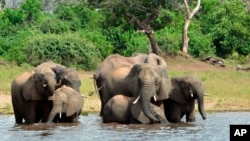The deaths of hundreds of elephants in Botswana earlier this year may have been the result of the animals drinking water containing poisonous blue-green algae. Algae are simple plants with no leaves or stems that grow in or near water.
About 330 elephants in the northwestern Seronga area died from a neurological condition. The cause appeared to be drinking toxic water, said Cyril Taolo. He is acting director of the Department of Wildlife and National Parks. A toxic flowering of “cyanobacterium” was found in seasonal water sources in the area.
Botswana’s government announced the finding Monday.
The unexplained deaths stopped after the water sources, or pans, dried up, Taolo told reporters in Botswana’s capital of Gaborone.
The Seronga area is close to Botswana’s famous Okavango Delta.
No other wildlife species were affected by the toxic water. Even animals like hyenas and vultures that were observed feeding on the elephant bodies showed no signs of illness, Taolo said.
Botswana has the world’s largest elephant population. An estimated 130,000 elephants can be found in the country. The animals bring many international tourists to Botswana.
Both male and female elephants of all ages died. The deaths happened mainly near seasonal water pans. The incidents did not spread outside the affected area, Taolo said.
After the mysterious deaths of the elephants, the government carried out extensive tests. The aim was to find out why the animals had died. The test results suggested that the elephants died from cyanobacterium, or blue-green algae, poisoning.
Taolo said neurotoxins from cyanobacteria living in affected water could have affected the brain signals of an animal. This might have caused paralysis and death, mostly related to breathing failure.
However, Taolo could not explain why the toxins did not affect any other animals drinking the affected water. He also said that there was no evidence of human efforts to kill the elephants through poisoning, hunting or other methods.
Talo said the government will immediately put in place a plan to examine seasonal water sources often. It will create methods for measuring and testing for toxins produced by cyanobacteria.
I’m Ashley Thompson.
The Associated Press reported this story. Ashley Thompson adapted it for VOA Learning English. Mario Ritter, Jr. was the editor.
________________________________________________________________
Words in This Story
neurological –adj. related to the nervous system which includes the brain, spinal cord and nerves
toxic –adj. containing a poisonous substance
source –n. the beginning of a river or stream, a place where water can be found
delta –n. a triangular area on a river where it widens and usually flows into the ocean
tourist –n. a person who travels for pleasure
paralysis –n. the inability to move a limb or body









